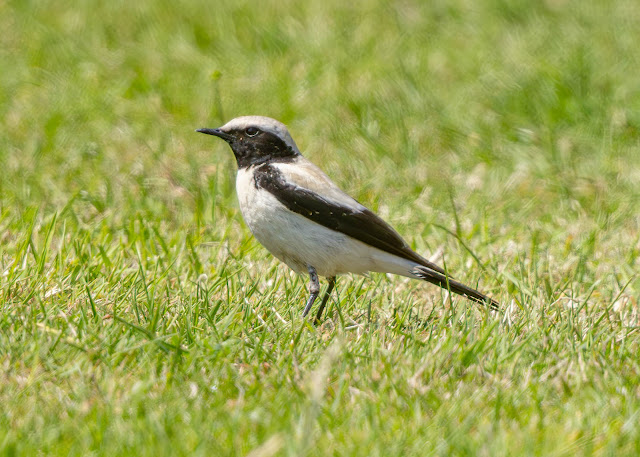There seems to be a bit of a developing theme here!
I checked our ‘birding the Uk and Ireland“ WhatsApp group as I was going to bed yesterday and discovered that a really stonking male adult Desert Wheatear had been found just an hour down the M5 from home! Again someone had posted a picture on social media of a bird that had apparently been present around the playing fields at Keynham for the last week.
I’ve seen Desert Wheatear in the UK before but never an adult male in summer plumage so when it was again reported early morning today a visit was a definite no brainer! I had a couple of jobs to do around our small holding first thing so it wasn’t until around 10:30 that I parked up and walk down to the reported position by Keynham playing fields.
I met Ady and his gang from Oxford and he told me that the Wheatear had just been flushed by a jogger. Bu**er! Had I got this one completely wrong? Should I have left home first thing?
In the end it was no panic as, after maybe 15 minutes, the Wheatear flew back to its favourite fence and , as they say, proceeded to “show well”.
Both western and eastern forms of the Desert Wheatear are rare vagrants to UK but I’m not sure that this bird has been tied down to subspecies level yet. The western subspecies breeds in the Sahara and the northern Arabian peninsula. The eastern race is found in the semi-deserts of central Asia and in winter in Pakistan and northeast Africa. So its fair to say that this little chap is well and truly lost! The plumage of the upper parts of the male in summer is buff. The underparts are white with a buff tinge on the breast. The black on the face and throat extends to the shoulders, and there is a distinct white superciliary stripe. It is a bird normally found in barren open countryside, steppes, deserts, semi-arid plains, saltpans, dried up river beds and sandy, stony and rocky wasteland, hence the name Desert Wheatear.
The behaviour of the Keynham bird was very similar to our comparatively common Northern Wheatear, perching up on the fence line surveying the grass land for insects. When one was spotted it would dash down onto the playing fields, snatch the insect and fly back to its perch on the fence.
 |
| cheating with photoshop! |
We typically get two or maybe three vagrants in the uk per year but most are autumn first winter birds like this one I saw in Devon with Jeremy some ten years ago. No disrespect to these first winter birds but the Keynsham adult in summer plumage was in another razzmatazz category all together.
 |
| First winter male, Devon, 2016 |
After maybe two hours and much too many photos, I left my film star bird, grabbed a quick lunch in a local café and then made my way home feeling very happy with my desert encounter.
Footnote – my blogs are posted with sometimes rather imaginative spelling and grammar due to my extreme dyslexia!





Comments
Post a Comment